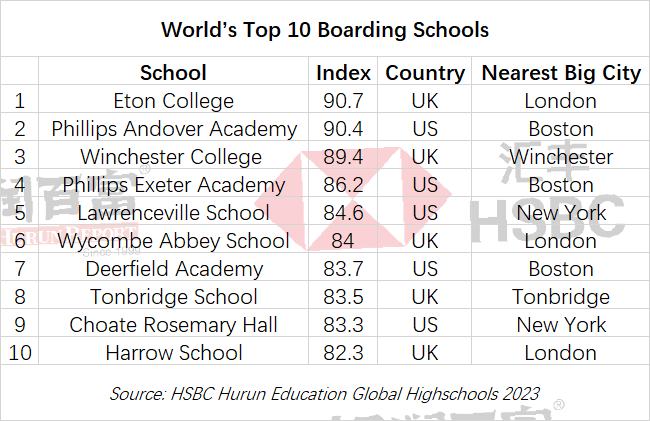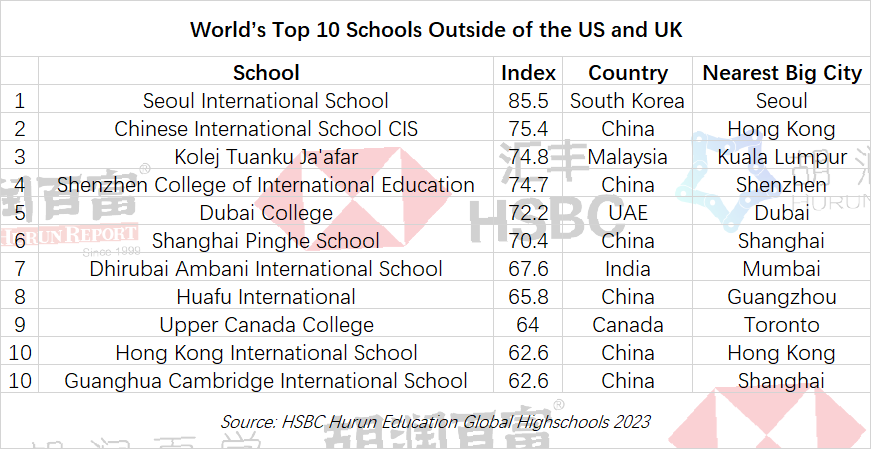Education investing: The world’s 10 absolute best elite high schools filthy money can buy
News
News
Hurun’s just released something they’re calling The HSBC Hurun Education Global High School list.
It’s basically the top 10 global blue chip high schools.
Global brands, all.
Consistent returns, high cash flows, generous margins and many with track records going back further than anything on the ASX today.
Apparently it’s the first ‘definitive list of the world’s independent high schools’, done in cahoots with HSBC, who must have their own reasons for plugging into the info.
In short:
The list is based on some pretty loose scientific methodology, consisting of:
a) where the graduates went next (60%)
b) co-curricular activities (20%) and;
c) reputation (20%).
Fortunately, if 20% of my reputation preceded me, I’d be out on my arse in the morning.
But the list – like so much Hurun produces these days – is fun, like a listicle pretending to be a vegetable, and as the old school tie still demands attention and some knowledge in the world of Finance.
They looked at schools from all over the world.
168 schools made ‘the final cut’, from 12 countries, led by the Poms and the Americans, which together made up 86% of the list.
“Perhaps surprisingly,” Hurun teases, 14 schools (8%) from China made the list, with 6 in HK and 3 in Shanghai.
Now that’s hardly surprising, since Hurun is based out of China, where it’s gone from Rupert Hoogewerf, Hurun Report’s chairman and chief researcher’s annual blog of China’s rich list into The Hurun Research Institute, closely tied – as all global businesses in China are – to their political patrons.
China lost some 164 billionaires last year, BTW, but Hurun says it’s still the global capital for billionaires – with 969 – ahead of the US, that’s according to the latest rich list released in March by the Institute.
The average age of the schools was just under 200 years, with 11 schools over 500 years.
70% are co-ed schools. Of the 30% that are single sex, two thirds are girls schools and one third are boys schools.
“Chinese parents have probably the most international mindset of any country that I know. I met someone recently with three children: the oldest was at high school in Japan, the middle one in the US and the youngest in the UK. This is much less unusual that many outside of China might expect,” Hoogewerf said.
China is the largest source of international high school students in the world, followed by India. South Korea, Germany and Saudi Arabia make up the Top 5.
“This is the first ranking of the best independent high schools in the world, targeted at parents looking to find the most suitable school for their children, teachers looking to work in the best schools, and university admission officers, looking to understand more about where their applications are coming from,” Hoogewerf said.
“Hurun Education has scoured the world for the best high schools of each region, taking into consideration only independent schools with physical campuses, and then ranking them based on leavers’ university destinations, co-curriculum activities and reputation.”
Hurun did not consider exam results, he said.
“The whole research process took over a year, and I would like to thank the many university counsellors, overseas education advisers as well as the schools for their support.”
48% and 38% of the world’s top high schools are from the US and UK respectively, and 8% from China.
By city, 26 and 24 schools are from London and New York, respectively.
Followed by Boston, Washington DC, Los Angeles, San Francisco, Shanghai and Oxford.
By region, the US East cost led with the most high schools on the list.
Nearly 3 in 4 (71%) are co-ed schools, while nearly two-thirds of the single-sex schools are all-girls.
Schools on the list on average have 990 students with 140 of them are in final year.
High schools on average have 195 years of history; 11 of them have over 500 years of history, while 20 with less than 50 years.
52% offer boarding, 48% day school only.

Average annual fees for boarding schools globally stand at USD60,000 and for day schools at USD40,000 a year.
Average 10% students receive financial aid; average grant 30% of the total school fees.
9% are based in the suburbs, a third in cities and 17% in rural areas.
London-based Westminster School topped the list, followed by St Paul’s School and St Paul’s Girls’ School.
Five US schools in top 10, all on East Coast led by Philips Andover Academy, followed by the Spence School, The Dalton School, the Collegiate School and the Brearley School.
“Most families look to a high school for an all-rounded education and to provide the best chance for a place in a well-reputable university,” Hoogewerf said.
“The schools on the Hurun list are highly selective, which is perhaps one of the reasons they are able to generate such good leaver results.”
China and India are far and away the largest sources of students studying abroad at highschool level, followed by South Korea and Germany, with Saudi Arabia rounding out the Top 5, according to a UNESCO report.
1.5 million of these high school graduates go on to study an undergraduate course in a country different to their home nation, 70% of whom studied in the US, UK, Canada and Australia, according to a 2020 Project Atlas report.
“With half of the world’s top 100 universities in the US and UK, it should perhaps not come as a surprise that the top feeder schools for these universities are predominantly from these two countries,” Hoogeworf said.
“China led the way in the world with the most world-class independent highschools outside of the US and UK, with more schools than the rest of the world combined.
“China’s top universities are predominantly only open to students from state schools, so the Chinese high schools that made the Hurun Education list are sending their students to study abroad.”
Twenty-five schools from outside of the US and UK made the list, led by Seoul International School in South Korea. Fourteen are from China, two from each of India and Singapore and one each from Australia, Canada, Hungary, Japan, Malaysia, South Korea, Switzerland and UAE.
The average size of school is 1,800 students with 190 graduates this year, with Singapore’s UWC of South East Asia and Singapore American School the largest with 5000 students.
The surveyed school on average has 54 years of history. Upper Canada College is the oldest school which was founded in 1829, followed by Institut Le Rosey in 1880 and Geelong Grammar School in 1885.
